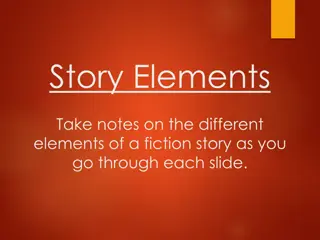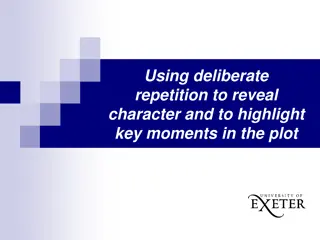Understanding Fiction: Essential Plot and Character Elements
Dive into the world of fiction with this comprehensive guide that covers essential elements such as plot structure, character development, conflict types, setting descriptions, and narrative perspectives. Learn about the key components of storytelling and how they shape engaging narratives. Save this valuable information for your exams and enhance your understanding of literary works.
Download Presentation

Please find below an Image/Link to download the presentation.
The content on the website is provided AS IS for your information and personal use only. It may not be sold, licensed, or shared on other websites without obtaining consent from the author. Download presentation by click this link. If you encounter any issues during the download, it is possible that the publisher has removed the file from their server.
E N D
Presentation Transcript
FICTION NOTES AEII 1 *This information will be on both semester exams so SAVE it in a safe place!
PLOT Series of events (blueprints) What happens in the story Chronological order EXAMPLE: Goldilocks and the Three Bears Goldilocks is hungry She finds the bears house She tastes the porridge Etc. 2 picturethisgallery.com
PLOTTERMINOLOGY Exposition Exposes characters and setting Background information is given Inciting action Beginning of the conflict Rising action Suspense/tension builds 3
PLOTTERMINOLOGY(CONTINUED) Climax Highest point of action/tension Turning point Falling action Conflict starts to be resolved Resolution All conflict is resolved Loose ends are tied up 4
CONFLICTSTRUGGLEORPROBLEM EXTERNAL CONFLICT Occurs outside of the character Man vs. man physical/verbal fight or argument with another individual 1. celebritiessite.blogspot.com Man vs. nature form of nature such as tornadoes, snowstorms, etc. 2. Man vs. society laws, social codes, etc. vi.sualize.us 3. 5 guysalvidge.wordpress.com
CONFLICT(CONTINUED) INTERNAL CONFLICT Occurs inside the character Man vs. self Feelings, thoughts, decision making 6 plagueofthemullet.com
SETTINGWHENANDWHEREACTIONTAKESPLACE (ASTORY CANHAVEMORETHANONESETTING) Mood Feelings created by the story The reader s emotions that are a result of reading the story (scared, happy, etc.) vimalbhaskar.blogspot.com Tone Author s attitude toward the topic he or she is writing about (serious, sarcastic, lighthearted) 7 cartoonstock.com
POINTOFVIEW - THEEYESTHROUGHWHICHTHEREADER SEES/EXPERIENCESTHEACTIONOFTHESTORY First person A participant in the story I, me, we, us Second person An advisor (self-help books) You Third person An observer; the fly on the wall that watches everything and everyone and reports on it They, he, she, it limited-narrator knows one of the characters thoughts and feelings Omniscient-narrator knows all of the characters thoughts and feelings 8
CHARACTERIZATION - METHODSOFREVEALING CHARACTERS (HOWWEGETTOKNOWACHARACTER) Methods Narrator s description (appearance of characters) 1. Character s own words, thoughts, and feelings 2. Character s own actions (what he or she does) 3. Other characters words, thoughts, and feelings 4. Other characters actions or reactions to the character 5. 9
TYPESOFCHARACTERS Flat (minor character usually) We see only one trait (ex: Sally skiing; that s all, nothing else is revealed about her) OR Round (major character) We see many traits (we see Sally skiing, scuba diving, bike riding, happy, sad) 10
TYPESOFCHARACTERS(CONTINUED) Static Stays the same throughout OR Dynamic Different: Changes on the inside; personality, behavior, or opinions change 11
TYPESOFCHARACTERS(CONTINUED) Protagonist Good guy; hero; keeps the action going OR keyposters.com Antagonist villain; tries to stop action from progressing; anything the main character struggles with or against 12 images116.bloguez.com
THEME- MAINIDEAOFTHESTORYABOUTLIFEORHUMAN NATURE (WHATISLIFELIKE? WHATAREHUMANBEINGSLIKE?) Literary techniques used to illustrate theme Figurative Language Wording not meant literally (face value) Example: I hit the books last night. (means I studied hard) 1. Simile - comparison using like or as (She was like a rose.) 13 2. Metaphor direct comparison; does not use like or as (He is a bear!)
LITERARYTECHNIQUES(CONTINUED) 3. Personification giving human traits to something that is not human (The wind screamed.) 4. Imagery language that creates a mental picture using the senses (sight, smell, hearing, taste, touch) 5. Symbol object stands for/represents more than it is (American flag=freedom) 6. Flashback relive past as if it were the present (The movie Scrooged.) 14
LITERARYTECHNIQUES(CONTINUED) 7. Foreshadowing hints about what will happen later in the story 8. Allusion reference to a famous person, place, event, or work of literature (Harriet Tubman was called the Moses of her time.) 9. Onomatopoeia word sounds like the sound it represents (hiss, drip, buzz) 15
LITERARYTECHNIQUES(CONTINUED) 10. Irony opposite of the expected (A Shriner on a motorcycle who works to save kids lives, hits a child and injures him at the parade.) Situational irony event that happens that is an unexpected twist at the end of the story Dramatic irony audience knows something a character doesn t know (Friday the 13th ch ch ch ) Verbal irony spoken words are the opposite of what is actually meant, felt, or true ( I love kids, said the mom as she locked them out of the house all day.) 16























